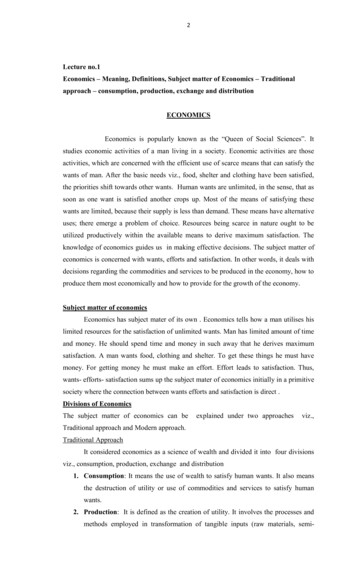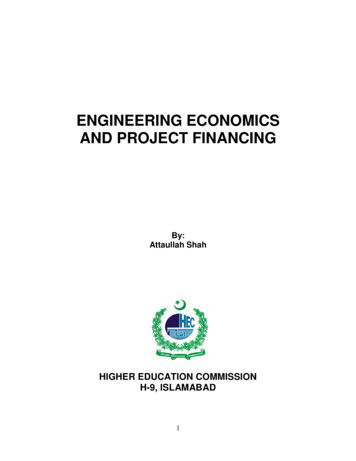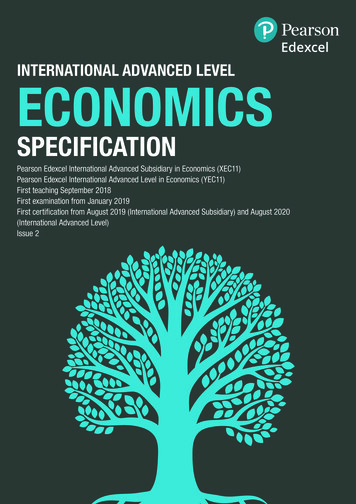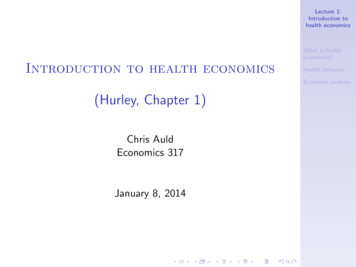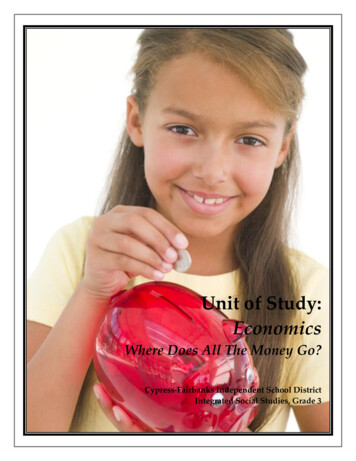
Transcription
Unit of Study:EconomicsWhere Does All The Money Go?Cypress-Fairbanks Independent School DistrictIntegrated Social Studies, Grade 3
Grade 3 – Unit 8Week at a GlanceWeek1Instructional FocusReading WorkshopWriting WorkshopEconomic Concepts: Earning,Spending, Saving, Donating, Budget(6A,B)IRL begins, Social IssuesBook ClubExpositorySocial Issues Book ClubFree Enterprise System Vocabulary (7B)Scarcity (7A, 7B)Free Market (7C)23&4Free Enterprise System: Simple Business(8A, 8B, 8C, 8D)5Free Enterprise System: Entrepreneurs(8E)6Technology Project (in iXplore)ExpositoryEOY DPM WritingBook ClubDramaEOY Revising &Editing DPM, NeedsBased Lessons,Book TrailersDramaBook TrailersGENERAL INFORMATION TEACHER NEEDS TO KNOW The lessons in this unit are geared toward the 3rd grade TEKS. Teachers areencouraged to modify these activities as needed and choose resources that best fittheir needs. INSS objectives should be visible. In the Unit Overview, the Bloom’s verbshave been underlined and critical skills have been color-coded. Vocabulary & current events resources are located in iXplore in INSS Resources. Lessons should be integrated into the reading/writing workshop schedule during thefollowing times; poetry, read aloud with accountable talk (20 minutes), independentreading and writing, group or share time. See the suggested schedule in iXplore. You can access Journey’s materials through the Think Central website. Someexamples of materials you can use for read a-louds include; the student e-book,leveled readers, vocabulary readers, decodable readers, and the write-in reader. Studies Weekly Free Trail – www.estudiesweekly.com – This site has some greatresources to use for integrated social studies. (username: TXteacher, password:demo)
Grade 3 - Integrated Social Studies CurriculumUnit 8: EconomicsUnit Length: 4 WeeksConceptual Lens:EconomicsSocial Studies TEKS:3.6(A) identify ways of earning, spending, saving, and donating money3.6(B) create a simple budget that allocates money for spending, saving, and donating3.7(A) define and identify examples of scarcity3.7(B) explain the impact of scarcity on the production, distribution, and consumption of goodsand services3.7(C) explain the concept of a free market as it relates to the U. S free enterprise system3.8(A) identify examples of how a simple business operates3.8(B) explain how supply and demand affect the price of a good or service3.8(C) explain how the cost of production and selling price affect profits3.8(D) explain how government regulations and taxes impact consumer costs3.8(E) identify individuals, past and present, including Henry Ford and other entrepreneurs in the communitysuch as Mary Kay Ash, Wallace Amos, Milton Hershey, and Sam Walton, who have started new businesses.Unit Overview:Students will identify the role of the U.S. free enterprise system and understand that this system may also bereferenced as capitalism or the free market system.Literature Selections:Teachers may choose a variety of literature for the read aloud selections to develop students’ understanding ofthe social studies concepts. See Appendix A for suggested literature selections.Grade 3, Unit 8, Draft April 2014Page 1
Economic Concepts Overview: Week 1Enduring Understandings/GeneralizationsThe student understands the purposes ofearning, spending, saving, and donatingmoney. Guiding/Essential QuestionsWhy do people need to earn money?How do people earn money (physical & mental labor in exchange for money)Do you get an allowance at home?What do you do with money you have earned? How do you spend it?Why is it important to save money?Why is it important to donate money to worthy causes?Have you ever benefited from someone donating their money?What is a budget and why is it helpful?How can you use a budget to help you with your earnings?Students will . . .participate in discussions and express ideas in a written format about the unit’s enduring understandings and guiding questionsuse primary and secondary sources to gain information about a topicunderstand key vocabulary termsidentify ways of earning, spending, saving, and donating moneycreate a simple budget that allocates money for spending, saving, and donatingGrade 3, Unit 8, Draft April 2014 Page 2
Teacher Materials Horizons Textbook (Unit 6)pp. 418-419: How People Earn &Use Moneyp. 420: Spending Moneyp. 421: Saving and Sharing Moneypp. 424-427: Saving Moneypp. 430-433: Making a Budgetpp. 436-441: People Who Share Appendix A – Suggested Literature Appendix B – EconomicVocabulary Graphic Organizer Appendix C – Lyrics to Where TheMoney Goes Appendix D – Modified BudgetActivity Economics Foldables - iXplore Budgeting Activity – iXplore Dragons Decide: Lesson III – aneconomic activity book withlessons and printable activitysheets-iXploreGrade 3, Unit 8, Draft April 2014Instructional Resources: Week 1Assessments (%)Teacher Notes See suggested Kidbiz Read Aloud discussion andarticles for this unit on p. 14.participation Written Response to guidingquestions Written response toindependent reading Anchor chart participation Economic VocabularyGraphic Organizer Budgeting Activity Page 3TechnologySchoolhouse Rock: WhereThe Money Goes (3:25)Government Website:http://www.kids.gov/k5/k5 money.shtmlHow to Earn Money s)Social Studies OnlineSecret Millionaires Club –video series developed byWarren BuffetScholastic Economics
Economic Concepts Pacing Guide: Week 1MondayVocabularyFocus: Unit Introduction Teachers create an anchorchart or projectable image toresemble Appendix B. Have students recreate it intheir ISN or print a copy ofAppendix B for each student. Have students jot down whatthey think each of thevocabulary terms mean. Suggested Terms: Earning – income or moneypeople earn for the workthey do Spending-money a personuses to buy goods andservices. It can be spent on awant or a need. Savings-money that you putaway to use later Donating-sharing moneywith a person or a goodcause View the Schoolhouse Rockvideo, Where the MoneyGoes. As the students view the video,have them revisit the graphicorganizer, check theirdefinition, and jot downexamples from the video.Grade 3, Unit 8, Draft April 2014TuesdayRead AloudFocus: Earning & Spending Conduct a read aloudusing Horizons textbookpages 418-420 or aselection from Appendix Aabout earning andspending money. During the read aloud,focus on the guidingquestions from the lesson.Have students turn andtalk about possiblepredictions and answers tothe questions. (%) Students may also stopand jot answers to theguiding questions in theirISN. (%) Revisit the graphicorganizer from Mondayand add any additionalexamples or information. Teachers may choose toenhance the lesson byusing a link or video fromthe Technology section.WednesdayRead aloud/Ind. ReadingFocus: Saving & Donation Conduct a read aloudusing Horizons textbookpage 421 or a selectionfrom Appendix A aboutsaving and donatingmoney. During the read aloud,focus on the guidingquestions from the lesson.Have students turn andtalk about possiblepredictions and answersto the questions. (%) Students may also stopand jot answers to theguiding questions in theirISN. (%) Revisit the graphicorganizer from Mondayand add any additionalexamples or information. Teachers may choose toenhance the lesson byusing a link or video fromthe Technology section. Students can use Horizonstextbook pages 424-427as independent readingto practice readingworkshop skills.Page 4ThursdayFridayRead Aloud/Ind. Reading/WritingFocus: Simple Budget Conduct a read aloud usingHorizons textbook Horizons textbookpages 430-433 or a selection fromAppendix A about making abudget. During the read aloud, focus on theguiding questions from the lesson.Have students turn and talk aboutpossible predictions and answers tothe questions. (%) Students may also stop and jotanswers to the guiding questions intheir ISN. (%) Revisit the graphic organizer fromMonday and add any additionalexamples or information. Teachers may choose to enhancethe lesson by using a link or videofrom the Technology section. Students are to create their ownbudget for earning, spending, savingand donating money using theBudgeting Activity in iXplore.Teachers should adjust the lesson tofit the students. (%)
Free Enterprise System Overview: Week 2Enduring Understandings/GeneralizationsThe student understands the concept of the freeenterprise system. Guiding/Essential QuestionsWhat makes something valuable and scarce?What benefit does a product have that makes it scarce?Who or what becomes harmed as more and more items are destroyed andbecome scarce? When a good, service, or natural resource becomes more and more scarce,what happens to the price? How do you solve a scarcity problem? Is scarcity actually good for business?Questions for The LoraxWhat type of resource were the Truffula trees?What were the Thneeds were made from?Why did consumers love Thneeds so much?What kind of resource was the Super-Axe-Hacker?Toward the end of the story, what happened to all of the Truffula trees?”Students will . . .participate in discussions and express ideas in a written format about the unit’s enduring understandings and guiding questionsuse primary and secondary sources to gain information about a topicunderstand key vocabulary termsdefine and identify examples of scarcity;explain the impact of scarcity on the production, distribution, and consumption of goods and servicesexplain the concept of a free market as it relates to the U. S free enterprise systemGrade 3, Unit 8, Draft April 2014 Page 5
Teacher Materials Horizons Textbookpp. 402–405: Free Enterprisepp. 406-411: The WorldMarketplace Appendix E -Scarcitydefinition, example, and song Appendix F-Scarcity GraphicOrganizer for read aloud. Dragons Decide: Lesson I – aneconomic activity book withvocabulary activities, lessons,and printable activity sheetsiXploreInstructional Resources: Week 2Assessments (%)Teacher NotesFreedom is the principle on Read Aloud discussion andwhich the United States wasparticipationfounded. Freedom is also the Written Response to guidingcornerstone of the Americanquestionseconomic system or free Written response tomarket. In this system,independent readingindividuals must make Anchor chart participationeconomic choices in an effort Vocabulary Graphicto satisfy their needs andOrganizer of Foldablewants. Decision Card activity Scarcity Graphic Organizer Suggested Terms: Free Enterprise – p. 371 in Horizons textbook Free Market- an economic market operating by free competition Scarcity – when a product Want – an item that is not needed for survival Need – an item that is necessary for survivalReview from 2nd Grade Producer- a person who makes and sells a product Production-the making of a product Consumer- a person who buys a product or service Consumption-when a product is used by a consumer Good-a tangible product Service- The action of helping or doing work for someoneGrade 3, Unit 8, Draft April 2014 Page 6TechnologyUnderstanding Scarcity.Discovery EducationAmazon search foreconomics books for kidsSocial Studies OnlineBrainPOP: Supply & Demand– this is not a free video, butthe information page isuseful.Secret Millionaires Club –video series developed byWarren BuffetScholastic Economics
Free Enterprise System Pacing Guide: Week 2MondayVocabularyFocus: EconomicConcept Review Teachers will buildbackground knowledgeby reviewing certaineconomic vocabularyterms with the studentsfrom 2nd grade. Create the followinganchor chart. Havestudents recreate thechart in their ISN orcreate a foldable to takenotes. Leave blanks forother terms discussed thisweek. WantNeedHave students jotdown what they thinkeach of thevocabulary termsmean (%).TuesdayWednesdayRead AloudRead AloudFocus: Scarcity, What is it? Ask students what they think the term “scares” means. Use Appendix E to introduce the term. This appendixexplains what scarcity is and gives an example. It alsoincludes a song that can be displayed in the classroom. Have students turn and talk to discuss other examples ofscarcity. As a class, come up with a giant list of goodsor services that can be scarce. All students will beencouraged to participate. At this point, the teachershould emphasize that people have to make important“economic choices” because resources and goods cansometimes be scarce. Add the word scarcity to their vocabulary graphicorganizer. Teachers can also use Dragons Decide: Lesson I iniXplore. The Decision Cards on p. 12-13 are a greatassessment activity. Give partners a card and havethem decide which option to choose and why? This canalso be done as an independent writing activity (%).Focus: How Scarcity Effects Production, Distribution, andConsumption Create or display the graphic organizer in Appendix F. Conduct a read aloud using The Lorax by Dr. Seuss oranother selection from Appendix A. During the readaloud, stop at key points in the story and have studentsturn and talk about the scarcity of the product and howit affected the way it was produced, consumed, anddistributed to consumers in the story (see guidingquestions section).Grade 3, Unit 8, Draft April 2014ThursdayThink AloudFocus: Free Market System Ask the students to definethe words “free” and“market”. Explain that a free marketsystem is a system whereproducers are free to sellwhat they want at theprice they want andconsumers are free topurchase what they wantwithout any interferencefrom the government. Conduct a read aloudusing Horizons textbookpages 402–405 or aselection from Appendix A During the read aloud,focus on the guidingquestions from the lesson.Have students turn andtalk about possiblepredictions and answers tothe questions. (%) Students may also stopand jot answers to theguiding questions in theirISN. (%)Page 7FridayCurrent EventsTeachers cancontinue aprevious lessonor havestudentsparticipate in acurrent eventactivity.Bring in currentarticles aboutitems that maybe scarce andhave studentscomment.Items areusually scarceduring ahurricane ornaturaldisaster.Students coulddiscuss whatitems may bein highdemand andwhy.
Simple Business Overview: Week 3 & 4Enduring Understandings/GeneralizationsThe student understands how businesses operate in the U.S. free enterprise system.Guiding/Essential Questions How does a simple business operate?In the American free enterprise system, people can choose what to produce, how to produce, how much to produce, and for whom toproduce with little government interference, taking advantage of principles of economic freedom, voluntary exchange, private property, andthe profit motive To start a business, a potential business owner first identifies goods and services needed in the community and gaugeswhether there is a large demand for a particular good or service and determines a process for offering the good or service to the community.If demand is high and of appropriate quality, the business pays production costs and labor costs, leaving a profit. Supply of raw materials anddemand goods and services are interdependent principles that affect cost, price, and profit. How does supply & demand affect the price of goods and services?High supply, low demand lower prices (e.g., the seller has to get rid of the product before it goes bad; if you overproduce a game or toythat nobody is interested in, the supply will be and the demand (market) is low, you will lower the price of the game to entice buyers)Low supply, high demand higher prices (e.g., people want the product before it can be made so the price rises for those who want theproduct; the price of a popular toy rises as demand rises. Also, production has to increase so more people have jobs.) How does production, selling price and other factors affect the profits? With demand stable, if cost of production goes up, the difference (profit margin) shrinksWith demand stable, if production costs go down, the difference (profit margin) widensDepending on the cost of production, the selling price may go up or down, in turn affecting profitDemand for the good or service also affects price which in turn affects profitIf it costs more to produce a good, the selling price has to go up to cover costs. If demand stays the same, profit margin will decrease.If it costs less to produce a good, the selling price could stay the same if the market supports that price. Then, profit margin will increase.If the market price changes, adjustments may need to be made in cost of production to remain competitive.How do government regulations and taxes impact consumer costs? Taxes are added to the costs of goods and services, increasingtheir overall cost to consumers. Government regulations set tax rates, set procedures requirements (building inspections, safety requirements),which costs are included when determining production costs, and setting prices consumers pay . Students will . . .participate in discussions and express ideas in a written format about the unit’s enduring understandings and guiding questionsuse primary and secondary sources to gain information about a topicunderstand key vocabulary termsidentify examples of how a simple business operatesexplain how supply and demand affect the price of a good or serviceexplain how the cost of production and selling price affect profitsexplain how government regulations and taxes impact consumer costsGrade 3, Unit 8, Draft April 2014Page 8
Teacher Materials Horizons Textbook:pp. 394 -398: How a BusinessWorkspp. 402-403: Supply &Demandpp. 88-89: Appendix G – Supply &Demand Comic Appendix H – Income &Expense Report Appendix I – Profit Poem Unit 8 Review - iXploreGrade 3, Unit 8, Draft April 2014Instructional Resources: Week 3 & 4Teacher NotesAssessments (%) Read Aloud discussion andparticipation Written Response to guidingquestions Written response toindependent reading Anchor chart participation Profit activity Unit 8 Review PPTPage 9Technology Teaching Kids Small BusinessSkills 15 Ways to Teach Kids aboutMoney Social Studies Online Social Studies for Kids Secret Millionaires Club – TheHigh Cost of High Demandvideo series developed byWarren Buffet Scholastic Economics
Simple Business Pacing Guide: Week 3MondayVocabularyTeacher canconduct activitiesusing suggestedvocabulary wordsto buildbackgroundknowledge.Suggested Terms: Simple Business an organizationinvolved in thetrade of goods,services, or bothto consumersTuesdayRead AloudFocus: How a Simple BusinessOperates Brainstorm a list of business in thecommunity. Conduct a read aloud usingHorizons textbook pages 394-398or a selection from Appendix A. During the read aloud, focus onGuided /Essential Question 1.Have students turn and talkabout possible predictions andanswers to the questions. (%) Students may also stop and jotanswers to the guiding questionsin their ISN. (%) Teachers may choose toenhance the lesson by using alink or video from theTechnology section.Grade 3, Unit 8, Draft April 2014WednesdayVocabularyTeacher canconduct activitiesusing suggestedvocabulary wordsto buildbackgroundknowledge. Havestudent create a 2tab foldableSuggested Terms: Supply- howmuch of a goodor service isavailable Demand-howmuchconsumers wantto purchase agood or serviceThursdayRead AloudFocus: Supply & Demand Explain to students when supply ishigh and demand is low, the pricegoes down. When the supply islow and the demand is high, theprice goes up. Teachers can use Appendix G(comic) as an introductoryactivity. View the video The High Cost ofHigh Demand Revisit pages 402-403 from theHorizons textbook. During the read aloud, focus onGuided /Essential Question 2.Have students turn and talk aboutpossible predictions and answersto the questions. (%) Students may also stop and jotanswers to the guiding questionsin their ISN. (%)Page 10FridayCurrent EventsTeachers cancontinue aprevious lessonor havestudentsparticipate in acurrent eventactivity.
Simple Business Pacing Guide: Week 4MondayVocabularyTeacher can conductactivities using suggestedvocabulary words tobuild backgroundknowledge.Students may create agraphic organizer or afoldable to organizednotes.Suggested Terms: Cost of Productionthe cost of materialsplus labor plusbusiness expenses Selling Price- thedifference betweenthe cost of productionand the selling price isthe profit Profit- money that isleft over after allexpenses have beenpaid (p. 396)TuesdayRead AloudFocus: How the cost ofproduction and selling priceaffect profits Explain to students thatmost people go intobusiness to make money.The money they get tokeep after all theexpenses are paid isknown as a profit. Teachers can use thepoem in Appendix G as alesson intro or wrap-up. Use the information inAppendix H and havestudent figure out howmuch profit the lemonadestand made by adding upthe money made on sellsand subtracting theexpenses. (%) What would happen ifthey raised the price of hislemonade? How could they lowercosts?Grade 3, Unit 8, Draft April 2014WednesdayVocabularyTeacher can conductactivities usingsuggested vocabularywords to buildbackgroundknowledge.Suggested Terms: Regulations-laws Tax- collected topay for communityservices such asschools, roads, lawenforcement, fireprotection, andemergencyservicesThursdayRead AloudFocus: How GovernmentRegulations and TaxesImpact Consumer Costs Explain to students thatlaws that the governmentpass and the taxes abusiness has to pay affectshow much consumers payfor goods & services. Conduct a read aloud using88-89 in the Horizonstextbook to build schemaabout taxes that arecollected. During the read aloud,focus on Guided /EssentialQuestion 4. Have studentsturn and talk about possiblepredictions and answers tothe questions. (%) Students may also stop andjot answers to the guidingquestions in their ISN. (%) Teachers may choose toenhance the lesson by usinga link or video from theTechnology section.Page 11FridayCurrent EventsTeachers cancontinue aprevious lessonor have studentsparticipate in acurrent eventactivity.Teachers canuse the Unit 8Review as awrap-up activityor an assessmentfor students. (%)
Entrepreneurs Overview: Week 5Enduring Understandings/GeneralizationsThe lives of heroic men and women who made importantchoices, overcame obstacles, sacrificed for the bettermentof others, and embarked on journeys that resulted in newideas, new inventions, new technologies, and newcommunities. Guiding/Essential QuestionsWhat is an entrepreneur?What qualities do you notice about the successful entrepreneurs?Why do you think the entrepreneurs were successful?What qualities do you share with these successful entrepreneurs?Students will . . .participate in discussions and express ideas in a written format about the unit’s enduring understandings and guiding questionsuse primary and secondary sources to gain information about a topicunderstand key vocabulary termsidentify individuals, past and present, including Henry Ford and other entrepreneurs in the community such as Mary Kay Ash,Wallace Amos, Milton Hershey, and Sam Walton, who have started new businesses.Teacher Materials Horizons Textbookpp. 372-375: Henry Ford’sDreampp. 378-383: Henry Ford Makesa Product Appendix J– Small BusinessPoster Appendix K - Henry Ford Bio Appendix L - Milton HersheyBio 3rd Grade Biographies - iXploreGrade 3, Unit 8, Draft April 2014Instructional Resources: Week 5Teacher NotesAssessments (%)Enrichment Activity: Divide the Read Aloud discussion andclass into 5 groups. Assign eachparticipationgroup a businessperson. Have Written Response to guidingthem add to their notes byquestionsconducting research on that Written response toentrepreneur. This research canindependent readingbe turned into a paper/pencil Anchor chart participationposter or a multi-media poster Small Business Posterto share with the class.Page 12 TechnologyBiography SitesMary Kay AshHenry Ford (also in Spanish)Wallace AmosMilton HersheySam Walton
Entrepreneurs Pacing Guide: Week 5MondayHolidayTuesdayRead AloudFocus: Henry Ford As a class, discuss the concept of entrepreneurship.Allow students to make predictions about what the termmeans. Entrepreneur - an individual who organizes andoperates a business or businesses Conduct a read aloud using Appendix J, the 3rd gradebiography of Henry Ford, Horizons textbook pages 372375 or a selection from Appendix A about Henry Ford. During the read aloud, discuss certain character andbusiness traits entrepreneurs display. Have students turn and talk about possible predictionsand answers to the questions. (%) Students may also stop and jot answers to the guidingquestions in their ISN. (%) Teachers may choose to enhance the lesson by using alink or video from the Technology section. Students can use textbook pages 378-383, independentreading to practice reading workshop skills.Grade 3, Unit 8, Draft April 2014WednesdayThursdayFridayRead AloudFocus: Mary Kay Ash, Wallace Amos, Milton Hershey, SamWalton Teacher can choose to concentrate on one of theentrepreneurs listed above. Conduct a read aloud using the 3rd grade biography,Horizons textbook, or a selection from Appendix A. During the read aloud, discuss certain character andbusiness traits entrepreneurs display. Have students turn and talk about possible predictions andanswers to the questions. (%) Students may also stop and jot answers to the guidingquestions in their ISN. (%) Teachers may choose to enhance the lesson by using a linkor video from the Technology section.Page 13
Suggested KidBiz Articles for Unit 8Grade 3, Unit 8, Draft April 2014Page 14
TopicsSuggested LiteratureTime for Kids Readers Earning, Spending, Saving, and DonatingMoneySimple BudgetScarcitySmall Business &Entrepreneurship Kids Making MoneyThere are activities on pp. 61-64 of the Time For Kids Teacher’s EditionSupermarket, Kathleen KrullA Chair for my Mother, Vera B. WilliamsThe Giving Tree, Shel SilversteinJennie’s Hat, Keats, Erza JackKaty and the Big Snow, Burton, Virginia LeeMy New York: New Anniversary Edition& Holiday Edition, Katy JacobsenPigs Go to Market, Amy AxelrodRumpelstiltskin’s Daughter, Diane StanleyTo Market, To Market, Anne MirandaHow to Make a BudgetThe Lorax, Dr. SeussThe Doorbell Rang, Pat HutchinsBringing the Rain to Kapiti Plain, Verna AardemoGetting’ Through Thursday, Melrose CooperOne Grain of Rice: A Mathematical Folktale, DemiReuben and the Quilt, Merle GoodSam and the Lucky Money, Karen ChinnThe Great Kopack Tree by Lynne CherryThe Mitten by Jan Brett Link to economy activityPet Peeve, Sarah WilsonLemonade for Sale, Stuart J. MurphyBetter Than a Lemonade Stand! Small Business Ideas for Kids, DarylBersteinEarning Money, Patricia MurphyThe Kid’s Business Book, Arlene ErlbachLittle Nino’s Pizzeria, Karen BarbourLoon Lake Fishing Derby, Kathleen WaldronVision of Beauty, Kathryn LaskyWhat’s the Big Idea, Ben Franklin, Jean FritzConsult your campus librarian for related titles that are available at your campusLIBRARY y el.htmCheck your campus library page for online resources to use for social studies contentlessons and read alouds. Grade 3, Unit 8, Draft April 2013Appendix A
ngDefinition:Grade 3, Unit 8, Draft April 2013Examples:DonatingExamples:Definition:Appendix BExamples:
Lyrics to Where the Money Goes:[Kid:]Dad, how come you or Mom can't pay for me to go on my band trip to the Rose BowlParade? Don't you make a ton of money?[Dad:]I don't know about that, but we do have a ton of expenses.[Kid:]Like what? Isn't there something here we can do without?[Dad:]We can stop buying groceriesBut that might be a mistakeBecause eating is a habitI'd be loath to try and breakWe can stop paying income taxBut they might send me to jailAnd if we don't pay the mortgageThen they'll take our houseThen where would we get our mail?If not for all these bills and taxesOur income would more than sufficeI feel like a real big cheeseUntil everybody takes a slice!I don't want to bore youWith my troubles or my woesStill you're old enough to knowWhere the money goesWe don't have to pay for furnitureIf you want to learn upholsteringWe don't really need to pay the phone billWe can use tin cans and a stringIt's bedtimeWe'd never have to pay to paint the houseIf we went off and lived in a caveAnd if you're planning on inheriting a million bucksThen there's really no need to save!We make a decent living, that's trueBut we have to pay these bills when they come dueGrade 3, Unit 8, Draft April 2013Appendix C
Please observe this illustrationWhich irrefutably showsExactly how and where the money goes[Dad:]You know if you could help us cut down on some of these expenses, I bet we could saveenough for you to go on that trip.[Kid:]What could I do?[Dad:]We could really lower the phone billIf you'd limit the length of your calls, byeYou could probably put some money in your savings bankIf you skip one trip to the mallWe'd spend a little less on electricityIf you turn off the light when you leaveAnd we could save a lot on our laundry billsIf you'd watch where you put your sleeve!You could bring a little in with a part time jobAll we ask is you do your bestIf you earn a little hereAnd save a little thereWe'll try to come up with the restWe can't stop the money from trickling outBut we can control how it flowsAnd we can start by being aware ofWhere the money goesWhere is my money?My money!It's goneGrade 3, Unit 8, Draft April 2013Appendix C
.50 1 2 2 2 3 4 4 6 6 7 8 10 10 10 15 15 15 25 35 40 45 45 60 80Items to buyCandyCookiesSong on ITunesPokemon/Yu-gi-oh CardIce CreamNotebooksPhone ApsNail PolishPostersMovie TicketBooksArt SuppliesLegoFootballJewelryClothesDVDBoard GameSoccer GoalSkateboardBa
Grade 3, Unit 8, Draft April 2014 Page 1 Grade 3 - Integrated Social Studies Curriculum Unit 8: Economics Unit Length: 4 Weeks Conceptual Lens: Economics Social Studies TEKS: 3.6(A) identify ways of earning, spending, saving, and donating money 3.6(B) create a simple budget that allocates money for spending, saving, and donating







